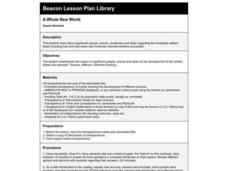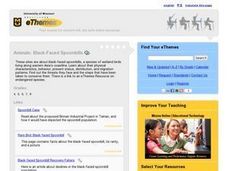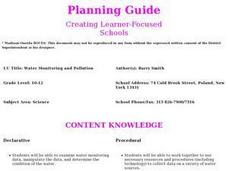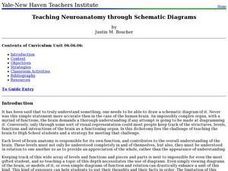Curated OER
Ugly? Says Who?
Students explore biology by writing animal poetry in class. In this animal characteristics lesson, students research the Internet for facts about an "ugly" animal such as a bug or small critter. Students complete worksheets about animal...
Curated OER
The Battle of Bunker Hill: Now We Are at War (42)
Students analyze historical and modern accounts of the Battle at Bunker Hill, and explain the importance of the Battle of Bunker Hill. They investigate and research their own community history for any significant events.
Curated OER
The Lunar Disk
Students analyze lunar material using actual moon rocks that were brought back by Apollo astronauts. The teacher and student activity sheets are well-designed.
Curated OER
Spanish-American War
Middle schoolers view a video called Battling Beyond the Borders about the Spanish-American War. They discuss the role of newspapers in the war and then analyze political cartoons of the time, writing explanatory sentences about them.
Curated OER
A Whole New World
Learners examine a timeline of a sequence of events displaying how the colonies were founded. They analyze Jamestown and Plymouth recruitment posters, write journal entries, and play a Jeopardy game with questions about the colonies.
Curated OER
Survivor Suitcases
Learners analyze and discuss how they would prepare for a trip to a desert island. They write a paragraph explaining why they chose their three items and how each help them to survive.
Curated OER
Animals: Black-Faced Spoonbills
Students analyze the physical characteristics, behavior, distribution and migration patterns of the black-faced spoonbills.
Curated OER
Graphing Made Easy
Fourth graders discover the appropriate way to construct and analyze bar, line, picto, and circle graphs. They set up frequency tables and perform some statistical analysis (mean, median, and mode) on their data.
Curated OER
Water Monitoring and Pollution
Students explore the effects of pollution on water supply and how to identify safe drinking water. They test different samples of water over regular intervals and analyze the results to see if they are cyclical or represent a growing...
Curated OER
Food Chains & Food Webs
Students examine the concepts of food chains and food webs. They trace back common food chains found in nature, demonstrate the interdependence of organisms through a food webbing activity, and analyze the flow of the food chain of a...
Curated OER
Weapons of War
Learners discuss how American and Great Britian attacked Afghanistan after September 11. They analyze different types of aircraft, missiles, and munitiions used in the attacks in Afghanistan.
Curated OER
The Ballad of the Sad Café
Students view the film "The Ballad of the Sad Cafe" and analyze it for stereotypes of mountain and hillbilly communities. They identify and discuss Appalachian values represented in the film and write a report on their observations.
Curated OER
About Abraham Lincoln
Fifth graders complete a unit of lessons on the life of Abraham Lincoln. They read and analyze a poem, create a timeline, write an essay, research The Gettysburg Address and The Emancipation Proclamation, explore websites, and interview...
Curated OER
Smoking: The Truth Unfiltered
Students view a PSB "In the Mix" documentary about smoking and tobacco abuse prevention. They discuss the video, identify the physical risks and effects of smoking and analyze smoking advertisements for marketing techniques.
Curated OER
"Love Must Not Be Forgotten" by Zhang Jie
Students read and analyze a story set during the Cultural Revolution in China. They answer discussion questions, discuss political and cultural revolutions, complete a reading survey, produce graphic organizers, and complete a Cultural...
Curated OER
Marine & Aquatic Habitats Activities - Walk in the Wetlands
Students research various types of fresh water wetlands and identify the common animal and plant life in these different ecosystems. They further analyze the need to protect these wetlands and explore their varied uses.
Curated OER
"Who Done It?" Analysis of Molecular Fingerprints Left At the Scene of the Crime
Students examine different types of DNA fragments. They record and analyze their results. They determine who is the criminal in the story.
Curated OER
Macroeconomic Policies
Students examine the main distinctions between the three key economic policies used by governments. They analyze key terms and learn to apply them to real life examples. They develop the key skills of analysis and evaluation.
Curated OER
Rates and Causes of Mortality in Classroom and Wild Monarch Larvae
Students observe, record and analyze the mortality rates of the monarch larvae that are being held in a controlled environment versus those that are in the wild.
Curated OER
From the Farm to Your Table: Where Does Our Food Come From?
Students discover where the food they eat comes from. Using maps, they identify the agricultural areas of the United States and the products that are grown in each area. Using the internet, they research how food gets to America from...
Curated OER
Teaching Neuroanatomy through Schematic Diagrams
Students identify the parts and function of a neuron. They explain and illustrate the levels and functions of the nervous system including neurons and the Central and Peripheral Nervous Systems. They analyze and diagram the Lobes and...
Curated OER
Creating Artwork to Explain Environmental Change
High schoolers review artwork that relates to the environment and communicates a value. They view and analyze art by Andy Warhol, Eric Carle and Albert Bierstadt and then create original pieces with an environmental theme.
Curated OER
Why is It That Johnny Can't Read?
Students listen to and discuss Don Henley's song, "Johnny Can't Read" and the 10,000 Maniacs song, "Cherry Tree." They research reading literacy and find statistics, evidence, stories, facts, and sources which will support their beliefs...
Curated OER
"Virtual" Model United Nations Day
Students identify and analyze that Global Interdependence and Internationalism have become major themes in human activity in the areas of population, environment, the world economy, and the United Nations.
Students identify the...

























